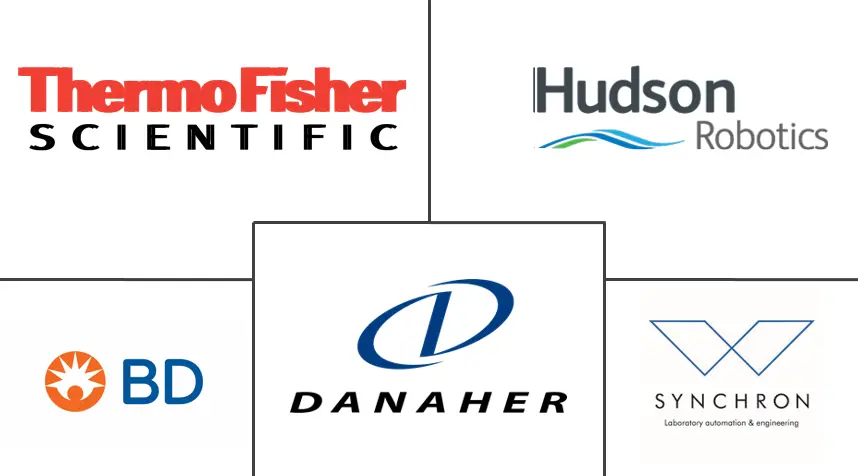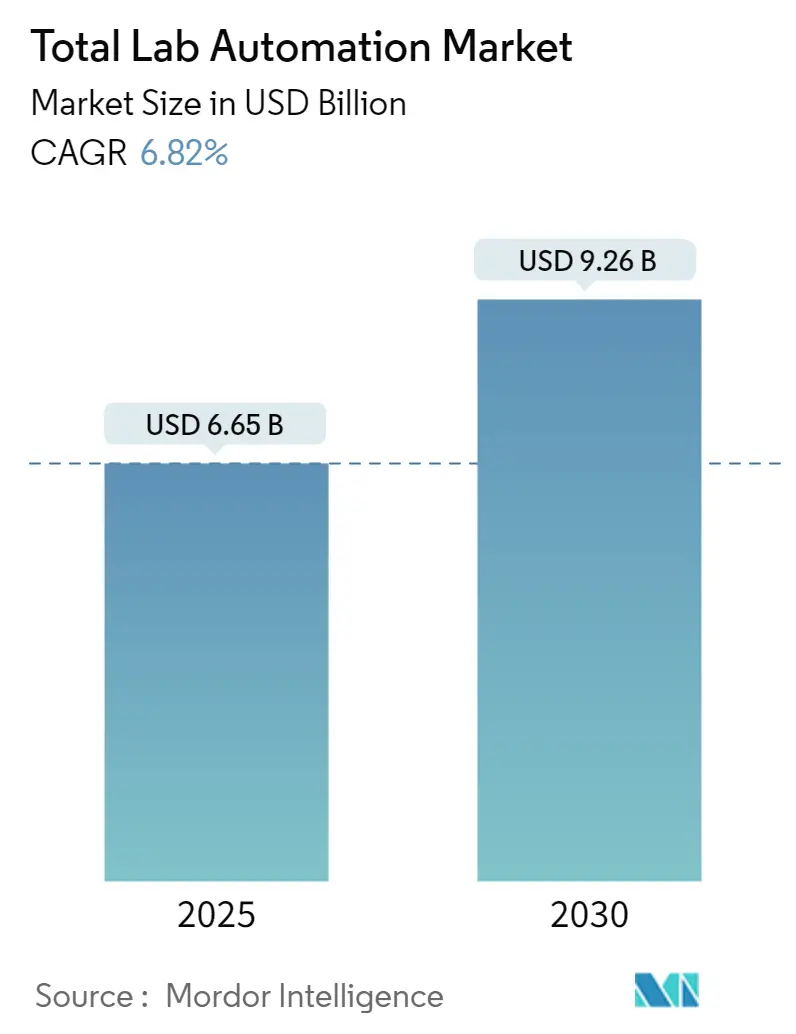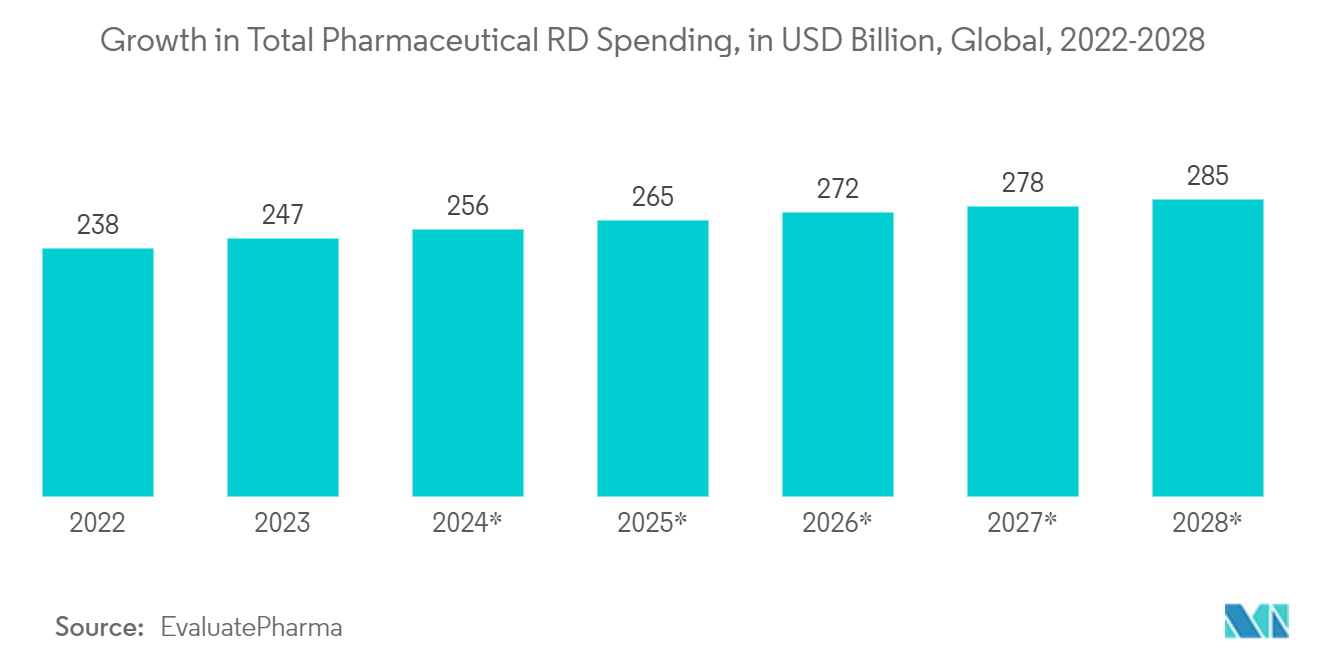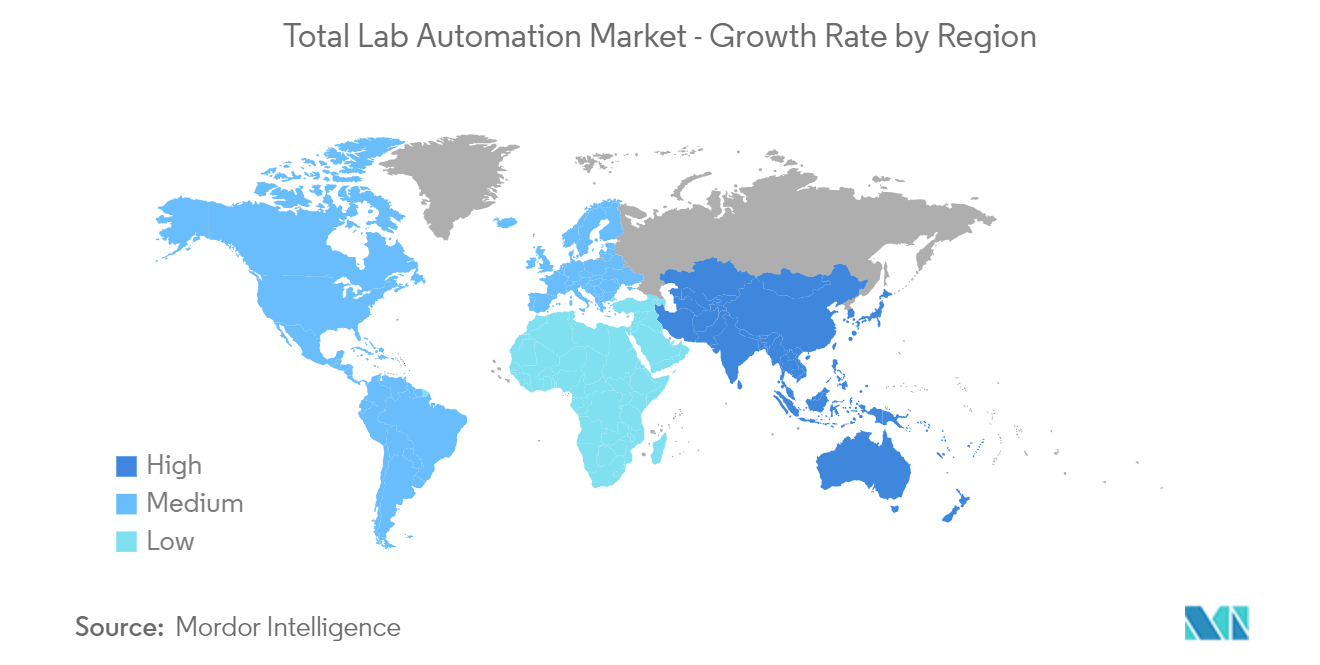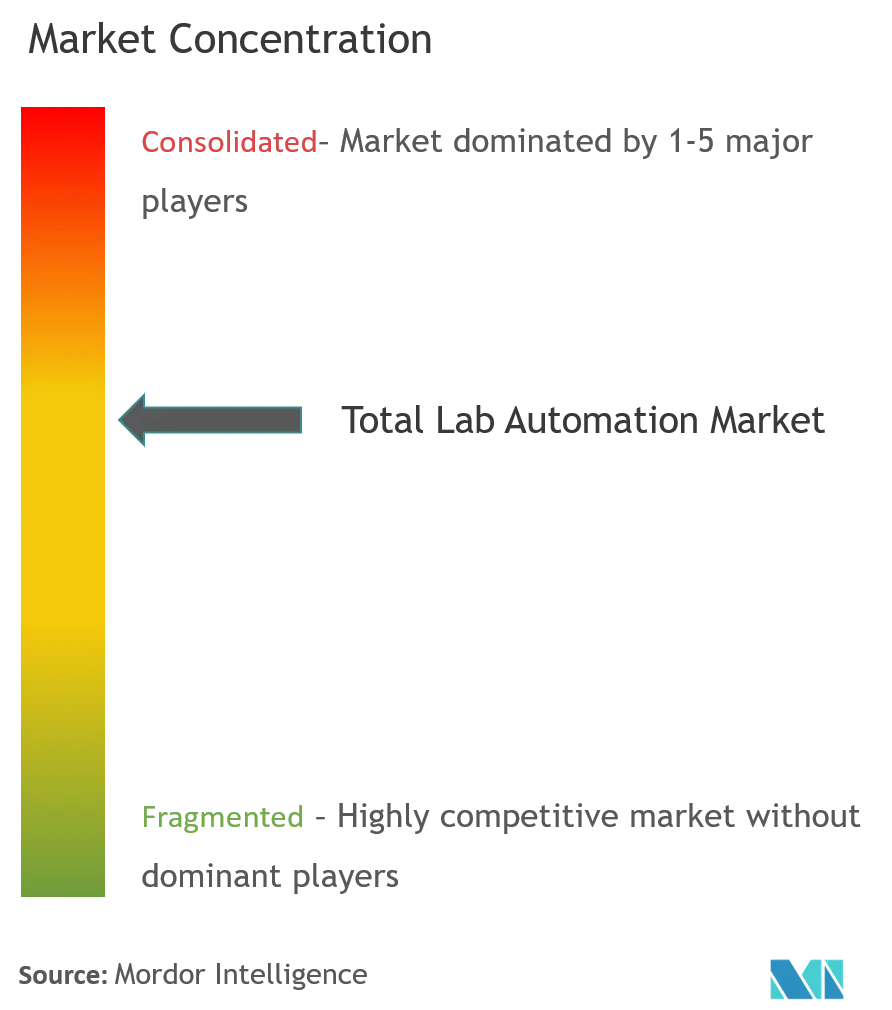Laboratory Automation Systems Market Analysis
The Total Lab Automation Market size is estimated at USD 6.65 billion in 2025, and is expected to reach USD 9.26 billion by 2030, at a CAGR of 6.82% during the forecast period (2025-2030).
Technological advancements and increasing pressure to deliver results have led to the use of automated systems in laboratories, driving the market. The adoption rate of automated systems has been growing due to their accuracy, advanced data management capacity, reduced repetitiveness, and reduced human intervention.
- Laboratory automation contains computerized lab instruments and gadgets, which give many advantages, such as expanded profitability, enhanced work process scope, reduced time cycle, and improved information quality. Lab automation is vital to handle large volumes of sample tests in less time.
- For instance, automated liquid handlers are widely adopted in lab automation since they drastically reduce the time for processing and minimize the scope for sample contamination by dispensing dead volumes very efficiently. Liquid handlers work on software using an integrated system, which customizes handling procedures with large transfer volumes.
- With users expecting an immersive experience integrated with the Internet of Things (IoT), industries are now more dependent on automation than ever before. The Internet of Things (IoT) explosion enabled everything to be connected wirelessly, including heating, badging, lighting, sample collection and testing, and security cameras. Robots are restocking shelves in the medical sector; in hospitals, lifesaving medical equipment is connected, whereas manufacturing connects heavy machinery. These applications will drive the studied market in the future.
- Furthermore, in November 2021, Automata announced the launch of Automata Labs, an accessible, worry-free laboratory workflow automation solution to empower life science labs to innovate and upscale at pace. It transforms labs of all shapes and sizes by providing scientists with accessible, flexible, and end-to-end lab automation.
- Laboratories are facing pressure to produce faster turnaround times while also reducing errors to enhance patient care and therefore are using automation and robotics pervasive in clinical laboratories. The high-end automation in instruments and modular systems offers an array of highly user-friendly features. Most instruments can be integrated with IT to maximize the benefits of laboratory automation, which offers mechanized solutions in each workflow phase in a lab.
Laboratory Automation Systems Market Trends
Drug Discovery Application is Expected to Hold the Largest Market Share
- The advancement of drug discovery may benefit from using high-throughput compound screening since these findings, together with those from fragment screening and computer modeling, can increase researchers' understanding of their potential therapeutic candidates. Consequently, improving the therapeutic candidates with the best chances of succeeding in clinical trials and receiving FDA clearance may be possible.
- This can benefit scientists as it helps guarantee that time and resources are not squandered on developing ineffective medication compounds. Clever automation of portions and machine learning can help reduce unpredictability and mistakes within drug development. It may also guarantee a more efficient drug discovery procedure with greater productivity and advancement in compounds linked to affecting biological targets inside a disease area for which the medicine is being developed.
- The drug discovery process gets FDA approval through a few medications. Nonetheless, lab automation, which may lessen human error and offer algorithms to increase the possibility of effective compounds, might be a useful strategy for speeding up drug development and assisting academics and pharmaceutical firms.
- In December 2022, InsilicoMedicine launched Life Star, which was the 6th generation Intelligent Robotics Drug Discovery Laboratory. The fully automated AI-powered robotics laboratory performs target discovery, precision medicine development, compound screening, and translational research. The lab will allow Insilicoto to accelerate its end-to-end drug discovery further and optimize the development rate of its drug development as it moves its novel therapeutics through clinical trials.
- Additionally, the companies are largely investing in drug research and development, thus positively impacting the market studied. For instance, in June 2023, Sun Pharmaceutical Industries announced an increase in R&D investment in specialty and generics businesses. According to the firm, its current generics pipeline for the US market includes 97 ANDAs, while 13 new drug applications are awaiting the US FDA's approval.
- As the success of drug discovery labs lies in optimized workflows, countless hours and resources are often spent on physically preparing and loading drug discovery and testing plates into readers. To make this process more efficient, several automation solution providers are including automated plate readers. For instance, Parkin Elmer is a leading automation solution provider for laboratories. The company's VICTOR Nivomultimode plate reader enables the user to set up walkaway automation - increasing the overall efficiency of the lab and accelerating the drug discovery process.
North America is Expected to Hold the Largest Share
- North America is expected to register a significant share due to the presence of the United States, which is a country with substantial investments in clinical research. This country is home to some prominent pharmaceutical companies, like Pfizer, Novartis, J&J, GlaxoSmithKline, and Novartis. The government also has a significant contract research organizations (CROs) concentration. Some of the prominent CROs in the country are IQVIA, Laboratory Corp. of America Holdings, Syneos Health, and Parexel International Corp.
- The market is highly competitive in the country owing to the presence of all the major players in the industry, as well as stringent FDA regulations. To avail an advantage over competitors, the market players in the country are rising, adopting robotics and automation in labs.
- Additionally, microbiological labs in the region seek technologically innovative solutions to handle large numbers of samples and limited personnel resources. Some prominent manufacturers, such as BD Kiestra and Copan Diagnostics Inc., have been commercializing partial or overall lab automation systems for bacteriology in the US.
- The North American region has regulatory bodies, such as the Centers for Medicare & Medicaid Services (CMS), that monitor and regulate all laboratory testing performed on humans in the US through the Clinical Laboratory Improvement Amendments (CLIA), which includes 260,000 laboratory entities. This presents a potential opportunity for the lab automation providers, which may propel the market's growth over the forecast period.
- For instance, Kaiser Permanente Regional Laboratories automated its lab with automated and semi-automated plating instrumentation, as approximately 80 percent of the bacteriology samples handled by the lab are preordained for processing and plating. In addition to this, lab automation improved plating quality and minimized ergonomic injuries by automating monotonous manual functions. Such developments are expected to encourage other labs in the region to follow a similar level of adoption to remain competitive.
Laboratory Automation Systems Industry Overview
The Total Lab Automation Market is moderately consolidated. The major players, such as Thermo Fisher Scientific Inc., Danaher Corporation, Hudson Robotics Inc., and Becton Dickinson & Co., Synchron Lab Automation, with a significant share in the market, are expanding their customer base across various regions. In addition, many companies are forming strategic and collaborative initiatives with multiple companies to increase their market share and profitability.
In March 2023, Brooks Automation US, LLC announced that it signed and completed an acquisition of Aim Lab Automation Technologies Pty Ltd. to expand solutions within the lab automation segment. This acquisition further expanded Brooks' presence beyond drug discovery into the clinical diagnostics market. Moreover, Aim Lab, in conjunction with PreciseFlex, will provide its customers with a broader set of capabilities, an expanded global presence, and the opportunity for enhanced collaboration with its customers.
In February 2023, Automata announced its expansion into the US to accelerate scientific and health outcomes by making automation a reality for every lab. Automata enters this market at an exciting and critical time, as the US is considered the global leader in Life Sciences, with more than a third of all life sciences companies headquartered in the country. The Company's technology is expected to provide the US with a significant cut in workflow times by up to 50 percent, increase output, maximize existing lab space, and free up scientists to work on innovative research.
Laboratory Automation Systems Market Leaders
-
Thermo Fisher Scientific Inc
-
Danaher Corporation
-
Hudson Robotics Inc.
-
Becton Dickinson & Co.
-
Synchron Lab Automation
- *Disclaimer: Major Players sorted in no particular order
Laboratory Automation Systems Market News
- May 2023: Opentrons announced the launch of its Opentrons Flex robot, a new generation of affordable and easy-to-program liquid-handling lab robots designed to level the playing field for labs of all sizes and bring advanced lab automation to more researchers than ever before.
- January 2023: Becton, Dickinson, and Company (BD) introduced the new third-generation BD Kiestra Total Lab Automation System for microbiology labs. The robotic track system works well with the BD Kiestramicrobiology laboratory solution, which automates the processing of lab specimens. The new robotic track system, created to address the changing needs of laboratories, will make it possible to create a whole lab automation configuration that is individualized and customizable and can link numerous BD Kiestramodules.
Laboratory Automation Systems Industry Segmentation
Total Laboratory Automation (TLA) is a laboratory automation system to carry out very repetitive activities. Robotic equipment is used in place of human operators to prepare and transport specimens.
The Total Lab Automation Market is segmented by Type of Equipment (automated liquid handlers, automated plate handlers, robotic arms, automated storage and retrieval systems (ASRS), and analyzers), by software (laboratory information management systems (LIMS), laboratory information system (LIS), chromatography data system (CDS), electronic lab notebook (ELN), and scientific data management system (SDMS)), by application (drug discovery, genomics, proteomics, clinical diagnostics, other applications), and by geography (North America, Europe, Asia-Pacific, and Rest of the World). The report offers market forecasts and size in value (USD) for all the above segments.
| By Type of Equipment | Automated Liquid Handlers |
| Automated Plate Handlers | |
| Robotic Arms | |
| Automated Storage and Retrieval Systems (ASRS) | |
| Analyzers | |
| By Software | Laboratory Information Management System (LIMS) |
| Laboratory Information System (LIS) | |
| Chromatography Data System (CDS) | |
| Electronic Lab Notebook (ELN) | |
| Scientific Data Management System (SDMS) | |
| By Application | Drug Discovery |
| Genomics | |
| Proteomics | |
| Clinical Diagnostics | |
| Other Applications | |
| By Geography | North America |
| Europe | |
| Asia | |
| Australia and New Zealand | |
| Latin America | |
| Middle East and Africa |
Laboratory Automation Systems Market Research FAQs
How big is the Total Lab Automation Market?
The Total Lab Automation Market size is expected to reach USD 6.65 billion in 2025 and grow at a CAGR of 6.82% to reach USD 9.26 billion by 2030.
What is the current Total Lab Automation Market size?
In 2025, the Total Lab Automation Market size is expected to reach USD 6.65 billion.
Who are the key players in Total Lab Automation Market?
Thermo Fisher Scientific Inc, Danaher Corporation, Hudson Robotics Inc., Becton Dickinson & Co. and Synchron Lab Automation are the major companies operating in the Total Lab Automation Market.
Which is the fastest growing region in Total Lab Automation Market?
Asia Pacific is estimated to grow at the highest CAGR over the forecast period (2025-2030).
Which region has the biggest share in Total Lab Automation Market?
In 2025, the North America accounts for the largest market share in Total Lab Automation Market.
What years does this Total Lab Automation Market cover, and what was the market size in 2024?
In 2024, the Total Lab Automation Market size was estimated at USD 6.20 billion. The report covers the Total Lab Automation Market historical market size for years: 2019, 2020, 2021, 2022, 2023 and 2024. The report also forecasts the Total Lab Automation Market size for years: 2025, 2026, 2027, 2028, 2029 and 2030.
Our Best Selling Reports
Total Lab Automation Industry Report
Statistics for the 2025 Total Lab Automation market share, size and revenue growth rate, created by Mordor Intelligence™ Industry Reports. Total Lab Automation analysis includes a market forecast outlook for 2025 to 2030 and historical overview. Get a sample of this industry analysis as a free report PDF download.

